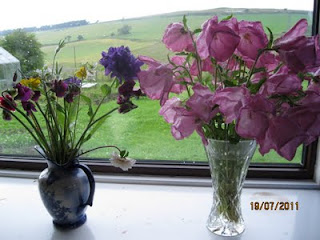
We grow broad beans at Cottarton. It’s about the only bean that does well in our challenging climate. We gather bushels of them. Each year we wonder what to do with them.
They’re not part of Amber’s kitchen repertoire, drawn mainly from Italian and French cuisine. The internet has some recipes. Complicated enough to make you suspect that the chef is trying to disguise the flavour of the beans.
And so I end up taking a bucket of bean pods to Scone where my kid sister Munia, newly arrived from Ecuador is taking care of my mother.

“But of course,” she said. “Those are habas. We lived on them for twenty years in Zumbawua.”
Zumbawua, in the high Andes at an altitude of 14,000 feet, has a climate not unlike Scotland. But there is no Tesco nearby. You subsist there on what you grow locally --- a diet high in potatoes and broad beans. And you learn to be creative about it.
That evening I picked up Munia’s boys at Prestwick. Coming from Northern Italy, they took the Ryan Air red-eye to to spend a few days with their mum. Actually, I had the “red-eye” having to pick them up at Prestwick (a two hour drive from Scone) --- at close to midnight. While driving there, I pondered what I would do to future guests who inflict such torture on me. No doubt some action that would make a tabloid headline. My flinty heart melted on meeting the kids, Juan, Simon, Estevan and Santiago. What could I do but give each a bear-hug!
When they arrived at Scone, after greeting their mum, they unloaded their bags --- Italian coffee, cheeses, cakes, pasta. I swear that half of their carry on luggage allowance (10 kg on Ryan Air) was food.
They’re different from kids I’ve known both in the US and in Europe. Growing up in the high Andes among the Indigenous People, something of the wild nature, unspoiled by civilization, rubbed off on them. They never saw a television except once in three years when they came to Europe. Never cared for fads or designer clothes. In the mountains they spoke a mix of Spanish and Quechua. Lived among people who had absolutely nothing. And they subsisted on broad beans.

Beans (double-peeled) and other garden fruit
Yesterday Juan and Simon double-peeled the “habas”, slowly as if it were a meditation. Double-peeling means shelling the beans then removing the outer husk from each bean. It was a daily chore they carried out for over fifteen years. Many times the volume I had brought because Munia had to feed fifteen people. Perhaps the activity awoke some nostalgia for the clear and cold mountain environment they’d left behind. From Juan I heard about the many ways of cooking the beans.
1. Deep frying in oil.
2. Boiling single shelled beans, salting, then eating the inner beans individually with your fingers while discarding the husk. Goes well with some bread and cheese.
3. Soup --- Juan’s favourite. You cook double shelled beans with bacon, then you puree them.
We had both the deep-fried and boiled beans. Both tasted extraordinary. Was it only the beans, or something of “soul” that had been added to them during the preparation?










